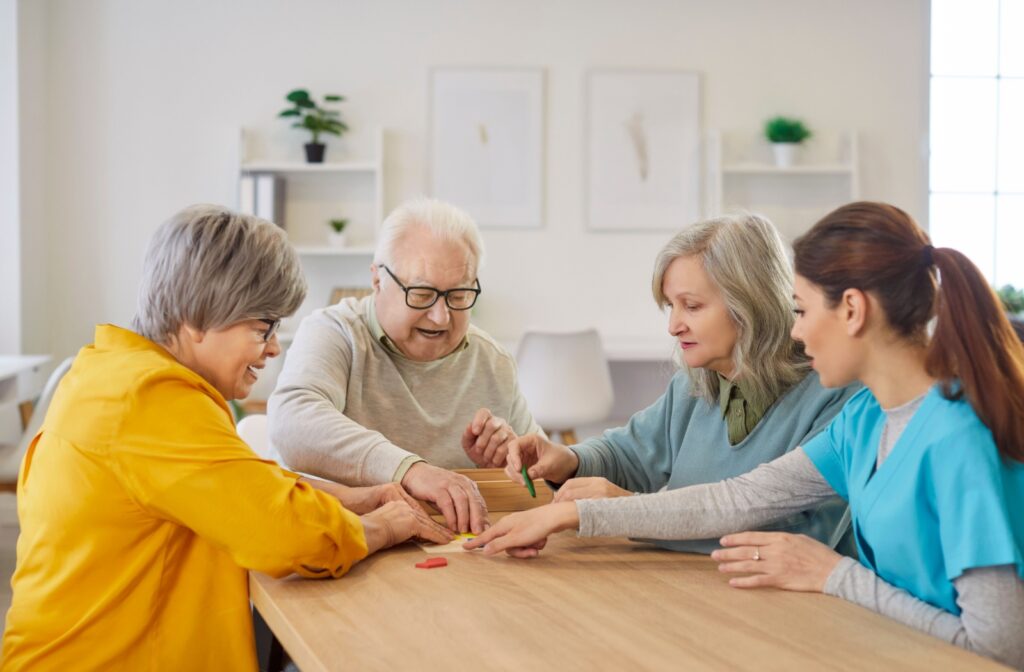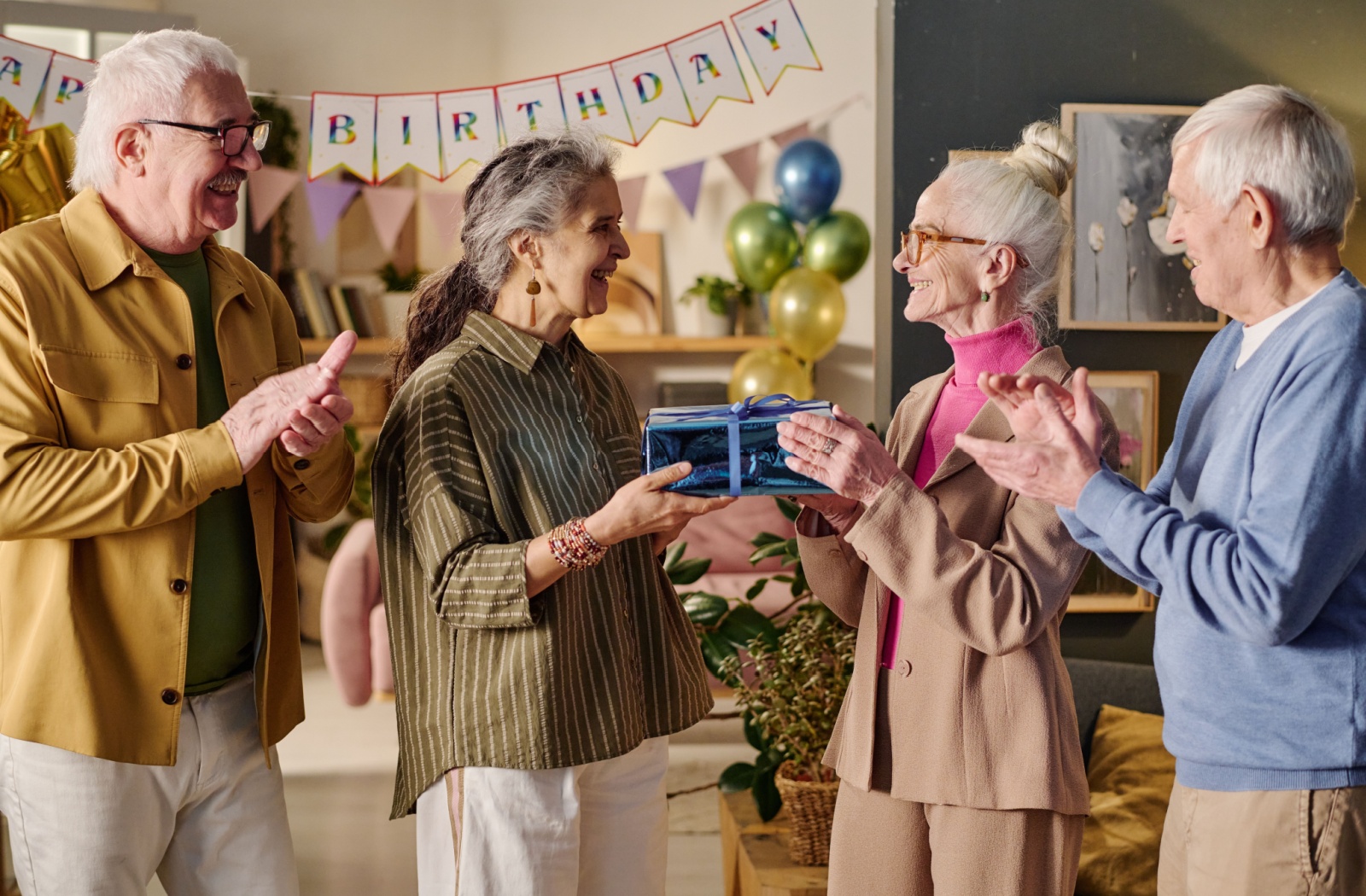Key Takeaways
- Staying social in assisted living promotes mental and emotional health.
- Daily activities, clubs, and shared dining encourage new friendships.
- Technology helps seniors stay in touch with family and old friends.
- Communities provide safe spaces for connection, growth, and fun.
- Family involvement supports strong and lasting social ties.
Building a social life in assisted living enhances overall well-being, reduces loneliness, and creates a sense of belonging. Seniors who remain socially engaged often experience lower stress, sharper memory, and better physical health. A full social calendar adds variety to daily life and provides meaningful structure.
Adjusting to a new community can feel intimidating, but assisted living is designed to make the transition easier. Residents can form friendships through shared meals, group activities, and casual encounters in common spaces.
Staying connected with family adds balance and comfort, while simple practices—like keeping an open mind, showing up consistently, sharing life stories, offering kindness, and maintaining a positive attitude—help seniors create lasting connections. Together, these opportunities and habits build a fulfilling lifestyle rooted in community and support.
Why Is Social Connection So Important in Assisted Living?
Social connection is a vital part of healthy aging. Older adults who maintain strong social ties often report greater life satisfaction, less depression, and a stronger sense of identity. In assisted living, opportunities for connection are woven into the environment, making it easier to stay engaged than when living alone.
Research shows that social engagement has far-reaching benefits. It lowers the risk of cognitive decline, supports heart health, and even boosts immunity. Recent findings reveal that social connections play a pivotal role in health outcomes and mental well-being, with 1 in 3 adults aged 50–80 experiencing feelings of isolation.
Emotional well-being is equally important—sharing laughter or a meaningful conversation can reduce stress and foster hope. In short, building a social life in assisted living isn’t just enjoyable— it’s essential for both mind and body.
How Do Communities Make It Easy to Meet New People?
One of the biggest advantages of assisted living is the built-in network of peers. Communities create opportunities for connection through structured activities, shared dining, and thoughtfully designed spaces.
Shared Dining Experiences
Meals bring people together. Dining rooms encourage residents to sit together, chat, and enjoy food in a warm, communal setting. Over time, these meals become an anchor for social life, creating friendships as natural as sharing a table.
Group Activities and Clubs
From card games and gardening to yoga or music groups, communities often offer a wide range of activities. These programs help residents connect with others who share similar interests and passions. Regular participation builds familiarity, turning acquaintances into close friends.
Common Spaces and Lounges
\Lounges, libraries, and outdoor patios are natural gathering points. Casual conversations often start here, and over time these interactions grow into lasting bonds. A resident might meet a neighbor in the garden one afternoon, then join them for bingo the next day.

What Are the Best Ways for Seniors to Stay Active Socially?
Remaining social doesn’t always require large groups. Seniors can enrich their daily lives with both big and small efforts to stay connected.
Join Regular Programs
Attending recurring activities like exercise classes, book clubs, or craft sessions provides consistency. Seeing the same people each week encourages recognition, comfort, and eventual friendship.
Volunteer Within the Community
Opportunities to volunteer—such as welcoming new residents or helping organize events—give seniors a sense of purpose while strengthening social ties. Even small contributions, like assisting staff during holiday celebrations, can create meaningful roles.
Explore Fitness Opportunities
Wellness programs often include walking groups, tai chi, or dance classes. These activities keep the body strong while encouraging camaraderie. For many residents, exercising together is both motivating and fun.
Embrace Informal Connections
A simple smile or greeting in the hallway can open the door to friendship. Sometimes the most valuable connections come from casual, everyday interactions.
How Can Technology Support a Social Life?
Technology makes it easier than ever for seniors to stay connected, especially with loved ones who live far away.
- Video calls: Services like FaceTime or Zoom allow face-to-face conversations across any distance. Weekly calls with children or grandchildren provide emotional comfort.
- Social media: Guided use of platforms such as Facebook helps seniors keep up with family milestones, share photos, and comment on updates.
- Community apps: Some assisted living communities use apps that provide event calendars, announcements, and even tools for connecting families with staff.
Even seniors unfamiliar with technology can learn with guidance from staff or family. Once comfortable, digital tools expand opportunities for connection far beyond the community’s walls.
How Do Families Play a Role in Social Engagement?
Family involvement strengthens a senior’s social life and helps them adjust to assisted living. When families stay engaged, seniors feel valued and supported.
Regular Visits
Frequent visits reassure loved ones that they remain an important part of the family. These visits don’t have to be long—even short chats or walks around the community provide comfort and consistency.
Attend Events Together
Joining celebrations, concerts, or themed dinners helps families share in community life. Attending these events also gives seniors a boost of confidence, knowing they are supported by familiar faces.
Encourage Participation
Families can motivate seniors to try new programs or meet new people. A gentle nudge to attend an art class or join a coffee social can help residents discover activities they may come to love.
What If a Loved One Struggles to Make Friends?
It’s normal for some seniors to take more time adjusting to a new social environment. Communities are equipped to help with this transition.
One-on-One Introductions
Staff often connect new residents with others who share similar backgrounds or hobbies, easing initial awkwardness.
Smaller Activities
Low-key programs like morning coffee groups or gentle exercise classes can feel less intimidating than large events, making them a good starting point.
Professional Support
If feelings of loneliness persist, many communities provide access to wellness coordinators or counselors who specialize in emotional support. These professionals can help seniors find confidence and new ways to connect.
How Communities Foster a Culture of Connection
The best assisted living communities design their environments with connection in mind. Activity calendars encourage residents to try new things, while open spaces make conversation easy. Staff members also play a role by facilitating introductions and supporting resident-led clubs.
Importantly, communities recognize that every resident is different. Some thrive in busy group activities, while others prefer smaller, more personal interactions. Offering flexibility ensures that every individual can find the social balance that feels right for them.
Your Choice for Assisted Living in Ocoee
A rich social life is one of the most rewarding aspects of assisted living. From shared meals and fitness classes to technology and family involvement, opportunities to connect are everywhere. With the right support, seniors can form meaningful friendships, stay engaged, and feel part of a thriving community.
At Inspired Living at Ocoee in Ocoee, FL, residents are surrounded by opportunities for connection. From personalized programs to inviting spaces, our community fosters friendships and supports well-being at every stage. Schedule a visit today to see how we help seniors thrive socially, emotionally, and physically.









